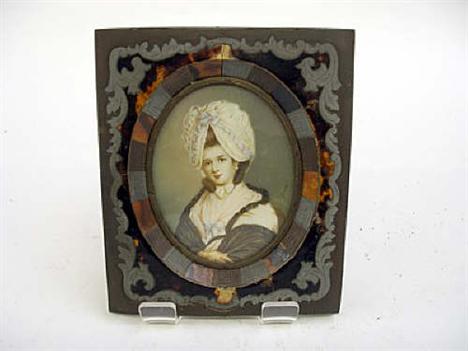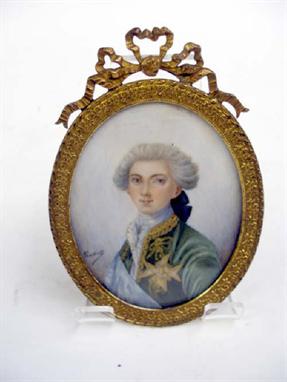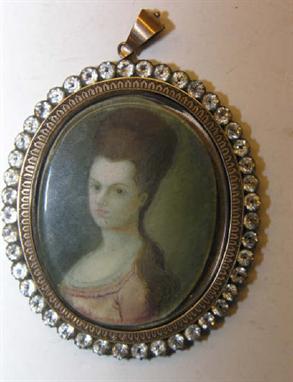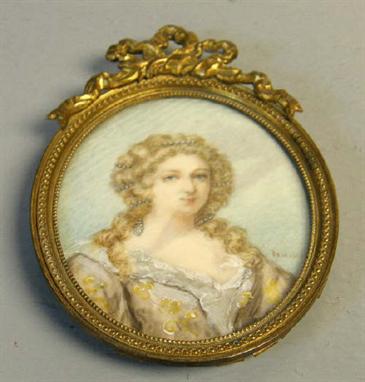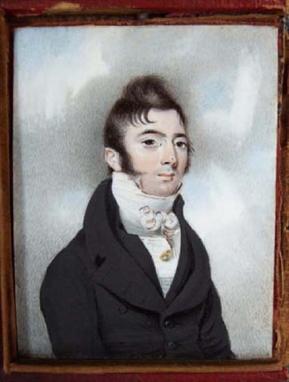We found 31366 price guide item(s) matching your search
There are 31366 lots that match your search criteria. Subscribe now to get instant access to the full price guide service.
Click here to subscribe- List
- Grid
-
31366 item(s)/page
Yellow Coloured Metal Set Shell Cameo Brooches with classical scenes, pair of clip-on Cabouchon & facet cut Garnet clip-on earrings set base metal, yellow coloured metal marquise shape Brooch with miniature portrait, 5 strand Seed Pearl necklace, yellow coloured metal & cultured single Pearl ring, Mutton Fat rectangular shaped Jade Pendant (7)
A XIX Century Gilt Metal Circular Pendant, inset with a head and shoulders portrait miniature of 'La Contesse Montespan', painted on ivory, (slightly damaged), 3 cms diameter in a red leather hinged case; A Continental Portrait Miniature, of a country girl, in a paste set gilt metal fob pendant, 4.5 cms diameter. (2)
A GOOD GOLD FRAMED PORTRAIT MINIATURE OF ELSIE MACKAY, Daughter of the Earl of Inchcape, together with a newspaper cutting on Elsie Mackay and share certificates. In a fitted case. Image 3.5 x 2.75ins. Note: Elsie Mackay died whilst attempting one of the first flights across the Atlantic Ocean.
General Service 1962, 2 clasps, Northern Ireland, Dhofar (24105622 Sig. D. A. Ware, R. Signals), in its card box of issue, together with related miniature dress medal and an S.A.S. cap badge, good very fine £400-500 Duncan Alexander Ware was born in May 1952 and enlisted in the Royal Signals at Edinburgh in September 1967. In his subsequent career of 18 years with the Colours he completed no less than four operational tours in Northern Ireland, the first of them in 1973 and the last in 1980, in addition to participating in the Dhofar operations in 1974-75. However, as verified by his Certificate of Service (copy included), he also served in the U.K. on a ‘classified’ basis on at least six occasions between 1977-81, namely during his employment with 264 S.A.S. Signals, so he may well have re-visited Northern Ireland on an operational footing during the periods in question. He was discharged with an ‘Exemplary’ conduct rating in July 1986; sold with a portrait photograph wearing his S.A.S. beret. £400-£500
A rare Fall of France 1940 D.F.M. group of four awarded to Flight Lieutenant L. S. Pilkington, Royal Air Force Volunteer Reserve, who was credited with 5 ‘kills’ as a Hurricane pilot in No. 73 Squadron prior to transferring to Spitfires of No. 111 Squadron and being killed in action on a Channel offensive sweep in September 1941: he was to have been married just six days later distinguished Flying Medal, G.VI.R. (741935 Sgt. L. S. Pilkington, R.A.F.); 1939-45 Star; Air Crew Europe Star; War Medal 1939-45, together with related dress miniature for the first, generally extremely fine (5) £5000-6000 d.F.M. London Gazette 16 July 1940: ‘For exceptional gallantry and devotion to duty in the air from January 1940, and especially from the 10-15 May 1940, during which period this airman pilot displayed unflagging zeal and courage in the face of superior forces of the enemy. He has shot down five enemy aircraft.’ Lionel Sanderson Pilkington, a native of Hull, entered the Royal Air Force Volunteer Reserve in 1938, qualified as a Sergeant Pilot and was posted to No. 73 Squadron, a Hurricane unit, and a component of 67 Wing, Advanced Air Striking Force, in early 1940 - records reveal him embroiled in a combat in Flight Lieutenant E. J. ‘Cobber’ Kain’s red section as early as 25 January. another followed on 26 March, when he fired all of his ammunition in a protracted dogfight with Me. 110s and Dorniers, one of the former hitting his propeller with return fire and causing him to drop 10,000 feet with a ‘spluttering engine’; so, too, on 21 April, when he got in a brace of attacks on 109s, one of them rolling over on its back. but it was after the ‘Phoney War’, on the advent of the German invasion of the Low Countries in May 1940, that No. 73 embarked upon a period of constant action, Pilkington noting in his diary as early as the 11th how he had to dive for cover at Reims-Champagne airfield, two bombs having landed yards from his quarters. Indeed his diary is extensively quoted in Twelve Days in May, by Brian Cull and Bruce Lander, with Heinrich Weiss (Grub Street, London, 1995): ‘[May 11] I get a Messerschmitt 110 but one also gets me! A cannon shot in the tailplane passes through the fuselage and out the other side! Bullets in the engine, shot away throttle control; cannot close throttle and bullet hits in cockpit, beside rudder bar. Land on [Rouvres] ‘drome by cutting switches, rudder control wire practically sheared.’ This action took place over Mourmelon, Pilkington flying Hurricane P2569/D - his victim was an aircraft from II/KG53, while ‘Cobber’ Kain also claimed a Bf. 110 on the same occasion. at first light on the 13 May, with the war correspondent Charles Gardner on hand to record events, Pilkington added a shared Do. 17 to his tally, in company with fellow pilots P./Os R. F. ‘Dickie’ Martin and D. S. ‘Don’ Scott, but the enemy aircraft’s rear-gunner was a good shot - ‘We all came back very riddled’. Again in combat that evening, this time against a brace of Heinkels near Vouziers, Pilkington saw one of them downed by Squadron Leader J. W. C. More - the crew managed to bale out but were lined up and shot by French troops on landing, or certainly according to Gardner. the very next day, in an early morning patrol over the Sedan battlefront, Pilkington and Flying Officer ‘Fanny’ Orton both seriously damaged Do. 17’s of 3/KG76, the former noting that large pieces came away from his Dornier’s starboard engine before his windscreen was covered in oil - ‘Also damage port engine and get the gunner ... Shots in my plane and I fly home as I cannot use my gunsight owing to the oil.’ The Dornier made it back to base, but with three of its crew wounded. later on the 14th, as one of six 73-pilots on a similar patrol, he engaged seven Stukas of I/StG76 over Malmy, his particular target diving into the ground and exploding, but then 73’s Hurricanes were jumped by 109s of III/JG53 and Pilkington’s fellow Sergeant Pilots, Basil Pyne and George Dibden, were both shot down and killed: ‘This is a hell of a blow to me. Hell!’ Notwithstanding such losses, 73’s punishing agenda continued apace, Pilkington sharing a claim for a Do. 17 with his C.O. on the following day: ‘Panic take-off. First off, chase some Heinkels but do not catch them. Come back to base and chase five Dorniers. Get starboard engine then jettison bombs. Crossfire gets me in oil and patrol tanks, also glycol. Get back to drome, glycol tank melted and run into engine. Face slightly burnt and eyes sore from glycol. C.O. says a good show.’ And in the air battles over Lille on the 19 May, again witnessed by the war correspondent Charles Gardner, he added another ‘probable’ to his tally - but as a result of damage caused by return fire was compelled to make a force-landing: ‘Think I got a He. 111 but one of the rear-gunners gets my oil tank and I fly back. See three He. 111s doing dive-bombing 200 yards away; also run into 15 Me. 110s. Fly back in cloud and land at French bomber drome. Given a fine lunch. Ken calls in a Maggie for me in the afternoon.’ His He. 111 was in fact most likely a Ju. 88 of KG51. at the end of the month, the first of 73 Squadron’s pilots were recalled to the U.K., but in common with No. 1 Squadron, their gallant part in the defence of France had been recorded for posterity by Noel Monks, another war correspondent who had followed their story from late 1939, and who subsequently published Squadrons Up! with such valuable combat experience under his belt, Pilkington was posted to No. 7 Operational Training Unit (O.T.U.) at Hawarden, Cheshire that July - and survived a prang with a student pilot in a Miles Master on the 17th. Far more unusually, he is credited with bringing down a Ju. 88, even though still based with No. 7 O.T.U., that September - an accompanying Tangmere Military Aviation Museum letter refers. sometime thereafter joining No. 111 Squadron, most probably in early 1941, when it commenced cross-Channel offensive patrols and escorts, he was shot down and killed by Me. 109s in a sortie to Hazebrouck in Spitfire AB-962 on 20 September 1941 - as Flight Lieutenant Keller concluded in his combat report for that date, ‘The Me. 109s on this occasion seemed to me to be making a far more concerted effort than usual and were present in greater numbers than hitherto’. Pilkington, by then a 22-year old Flight Lieutenant, was due to have been married on the 26th. He has no known grave and is commemorated on the Runnymede Memorial. sold with a quantity of original documentation, including Buckingham Palace condolence message; four wartime photographs, one a framed portrait, and another of a page in his Flying Log Book, carrying an endorsement from his 73 C.O., ‘Has proved himself a gallant and successful Fighter Pilot’, in addition to details of a claim for an He. 111 above; an R.A.F. permanent pass, for St. Athan, No. 11 Group, in the name of ‘741935 Sgt. L. S. Pilkington’, dated 21 November 1939; together with the remnants of his embroidered cap badge, his uniform ‘Wings’ and, most poignantly, his fiancee’s R.A.F. sweetheart’s brooch, gold and enamel. £5000-£6000
Waterloo 1815 (Capt. & Bre. Maj. A. Kuckuck, 3rd Line Batt.) fitted with original steel clip and small ring suspension, together with a fine oval miniature portrait of the recipient in uniform wearing his Waterloo medal, oils on ivory, unsigned; a gilt badge with GRV cypher from his later Hannoverian service; ‘Peacock’s Polite Repository or Pocket Companion’ for 1818, with hand written eulogy to the K.G.L. with reference to their services at Waterloo given by the Duke of Cambridge, bound in red leather; a wax seal impression, and a group photograph of officers in the Hannoverian service, the reverse inscription identifying ‘Grandfather Kuckuck-Wahren’, nearly extremely fine £4000-5000 johann Augustin Julius Kuckuck was born in the Kingdom of Hannover in about 1767. He was married at Einbeck on 18 August 1788, and subsequently had five children. He joined the newly formed King’s German Legion on 15 September 1804, being appointed as Captain of a Company to the 3rd Line Battalion, and served in the expedition to Hannover in 1805-06. In 1807 he took part in the expedition to the Baltic, and from 1808 to 1814 he was stationed on the island of Sicily in the Mediterranean. Promoted to Brevet Major in the 3rd Line Battalion in June 1814, he was stationed in the Netherlands during the latter part of that year, and took part in the campaign of 1815 and the battle of Waterloo. He was promoted to substantive Major in the 5th Line Battalion in September 1815 and placed on half-pay on 25 April 1816, upon the reduction of the King’s German Legion. For his services at Waterloo he was awarded the Prussian Order of the Red Eagle, 4th Class, and the Hannoverian Wilhelm’s Cross. He was later promoted to Colonel on the half pay by brevet and became Commandant at Hildesheim. Sold with copy statement of service in which he points out that of his three Christian names only August, contracted from Augustin, had ever been inserted in his Commissions, and that he would continue to do the same until further orders; dated Hildesheim, 22 December 1828. £4000-£5000
ENGLISH SCHOOL 19TH CENTURY OVAL MINIATURE PORTRAIT of a Gentleman wearing white necktie and black jacket, on ivory, unsigned, in original ebonised frame, size of portrait 7cms x 5.5cms together with another oval miniature portrait of a woman, on ivory and in ebonised oval frame (damaged) (2)
* NOTE:SITTER IS GENERAL SIR CHARLES NAPIER (1982-1853).An Anglo-Indian School Portrait Miniature, mid 19th century, depicting a bearded officer facing right, bust length, in a scarlet coat with gold epaulettes and scarlet shoulder belt, wearing the Order of the Bath, in an oval gold plated mount, 5.2x4.4cm.
William Derby 1786-1847- Portrait miniature depicting a 17th century lady, seated wearing a green velvet dress with white lace collar, cuffs and head dress, holding a locket; watercolour on ivory, signed "W Derby Pinx"(top left) and inscribed "For Charles" (top right), bears Horace Dawes, Lonsdale Gallery, label attached verso, in a gilt frame, 13x10.5cm. Note: William Derby was well known as a copyist, some of his works were engraved and he exhibited at the RA, RBI, OWCS and NWCS.
Fore-edge painting.- Southey (Robert) THE POETICAL WORKS additional engraved title and frontispiece, light foxing, prize plate on front pastedown, contemporary crushed morocco by Wells, gilt, some sunning affecting rear board, spine gilt, g.e., 4to, 1884. *** The fore-edge painting depicts a well executed portrait miniature of Southey with Greta Hall, Keswick in the background.
A miniature bust portrait of a lady (possibly Elizabeth Mary Pemberton); an early 19th Century thin gold wedding ring, in green morocco leather-covered case; a small leather-bound lady's almanac for the year 1785; a small collection of miniature ivory items, to include: a comb; pair of scissors; etc.; Georgian gilt tokens, in leather pouch; together with a small 19th Century rectangular cardboard box, with green print cover.
-
31366 item(s)/page
















